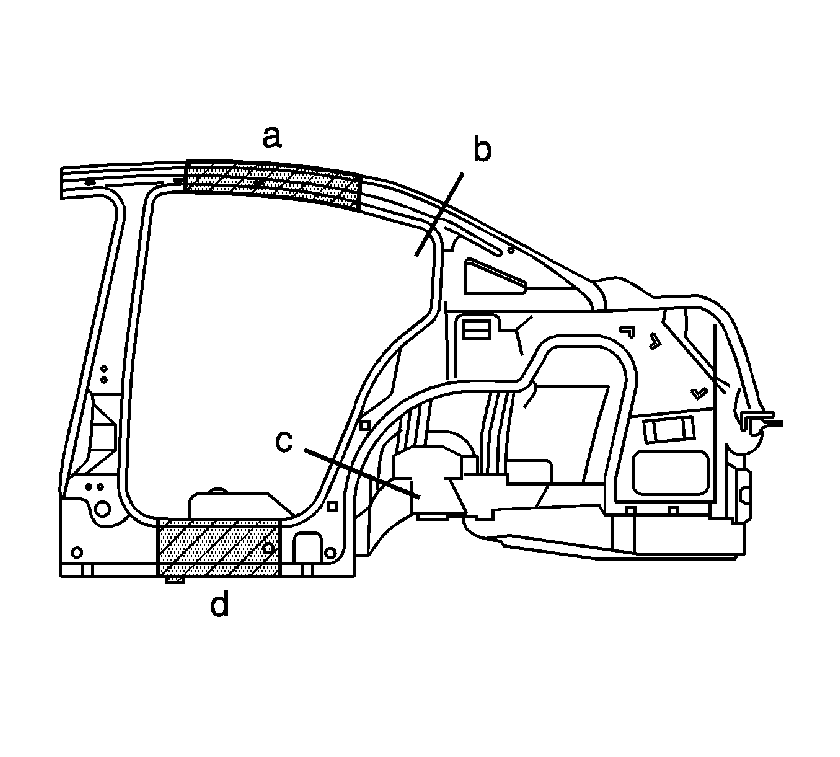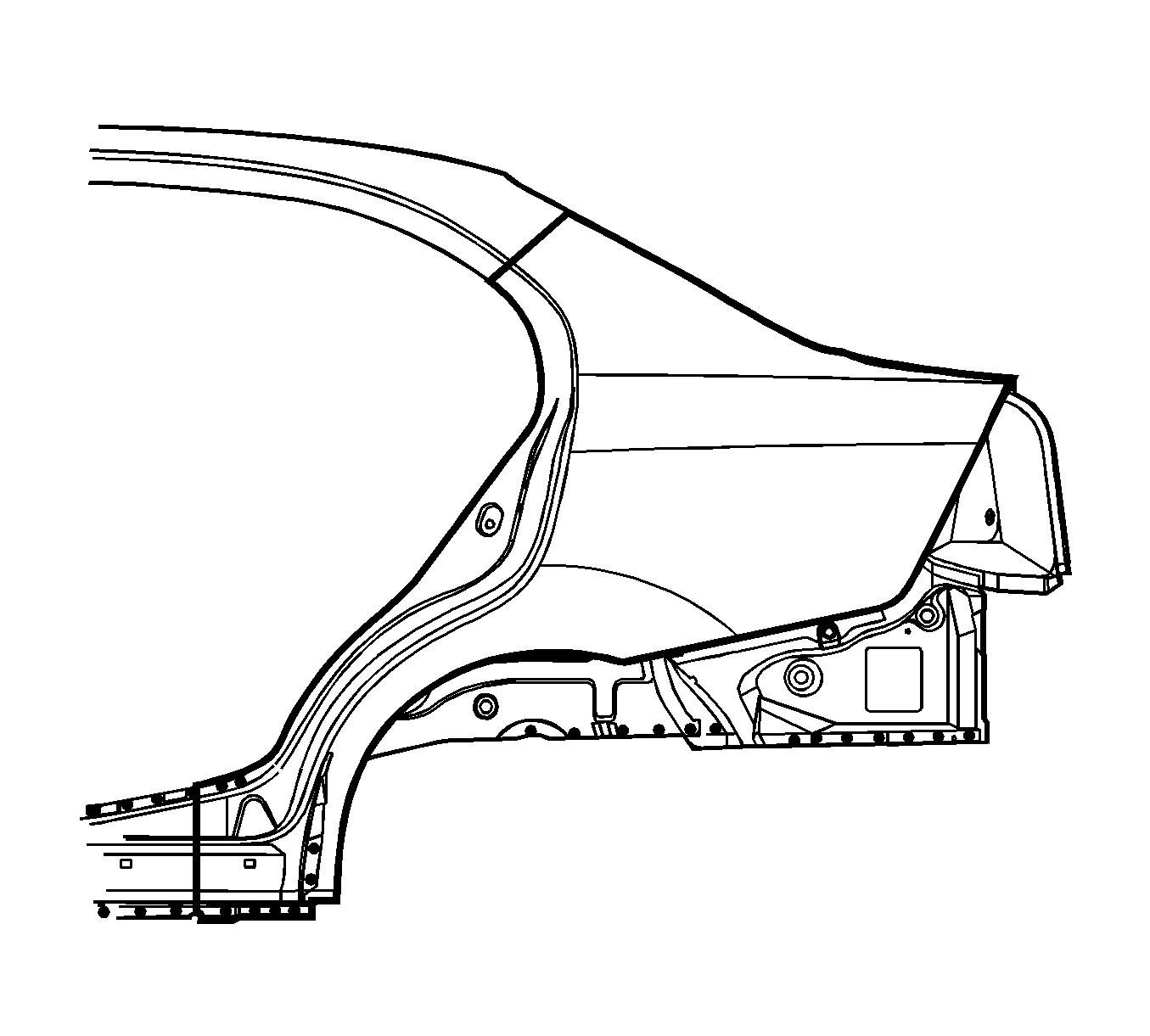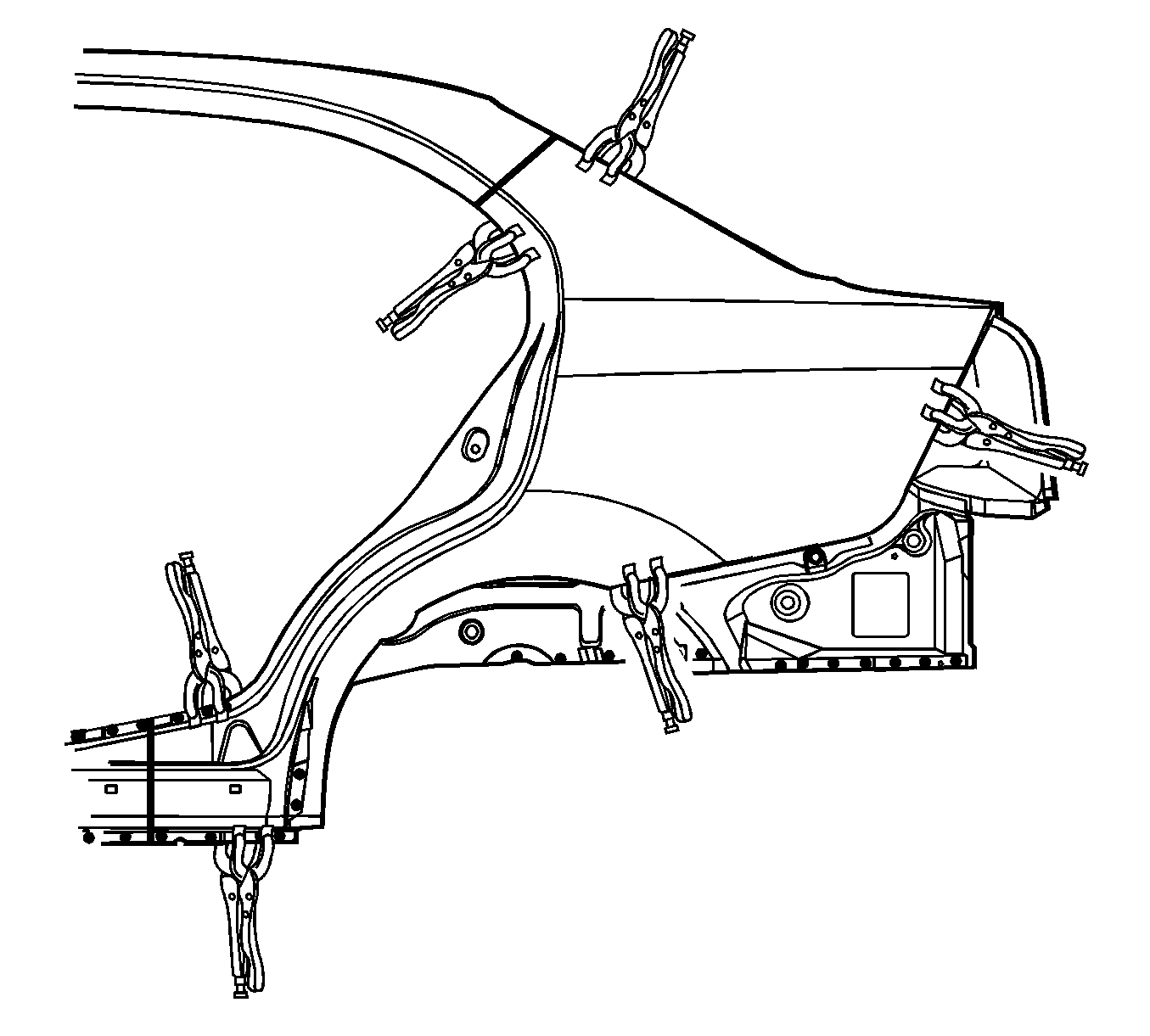Removal Procedure
Important: The side panel outer consists of side outer area and frame door area. The side outer area is a conspicuous part of the outer appearance of the vehicle. It is especially important for the body line continuing from door. Therefore, pay particular attention to it when conducting work. This part must be aligned with the rear door, tailgate and other parts.
Caution: Refer to Approved Equipment for Collision Repair Caution in the Preface section.
Caution: Sectioning should be performed only in the recommended areas. Failure to do so may compromise the structural integrity of the vehicle and cause personal injury if the vehicle is in a collision.
The body side outer panel is available either in one piece or in front or rear portions. The front and the rear halves are cut about half way across the rear door opening. You can perform any one of these replacement procedures separately or in any combination, depending upon the extent of damage to the vehicle. Sectioning must take place in specified areas only. Stay away from the door and window opening radius areas. Section only in straight areas of the openings.
- Disable the SIR system. Refer to SIR Disabling and Enabling .
- Disconnect the negative battery cable.
- Remove all related panels and components.
- Repair as much of the damaged area as possible. Refer to Dimensions - Body .
- Remove the sound deadeners as necessary. Note their location.
- Remove the sealers and anti-corrosion materials from the repair area, as necessary. Refer to Anti-Corrosion Treatment and Repair .
- Sectioning can be performed at any of the following locations:
- Within the recommended sectioning areas, mark the location of the sectioning cut lines on the vehicle.
- Locate and drill out all factory welds.
- Cut the panel at the location laid out in the previous steps.
- Remove the damaged quarter panel.

Important: Perform sectioning only in the recommended areas of the rocker panel, dog leg, sail panel, and upper roof rail area of the body side panel as necessary.
| Important: Avoid areas in the radius corners for the rear header attachment locations. |
| • | (a) - The butt joint and the weld backer, located on any straight area along the top of the rear door opening forward of the header panel and rearward of the center pillar radius. Use a 100-mm (4-in) welding backer. |
| • | (b) - The overlap and the plug weld joint, located 50 mm (2 in) rearward of the last upper trim attachment slot. This joint will be an overlap. Cut the service port 10 mm (3/8 in) rearward of the same upper trim attachment hole. |
| • | (c) - The butt joint and the weld backer, located 75 mm (3 in) down from the lower edge of the square hole on the exterior panel attachment of the top quarter panel. Use a 50-mm (2-in) weld backer. |
| Important: Avoid areas in the lower radius corners, at the bottom of the center pillar, and at the bottom of the dogleg in the door opening. |
| • | (d) - The butt joint and the weld backer, located on any straight area along the rocker panel between the door opening. Use a 100-mm (4-in) weld backer. |

Important: Note the number and location of the factory welds for installation of the quarter panel.
Important: Do NOT damage any other panels or reinforcements when cutting at the marked locations.
Installation Procedure
- Locate the area on the service panel where you will perform sectioning.
- Measure and mark the cut line location on the service part.
- Cut the service panel so it will overlap by 30 mm (1.18 in.) in the frame door opening area.
- Create backing plates of the specified length from the unused portion of the service part.
- Trim the backing plates as necessary to fit behind the panel at the sectioning joints.
- Drill 8 mm (5/16 in) plug weld holes along the sectioning areas in the service part. Drill the plug weld holes 15 mm (5/8 in) from the edges.
- Drill 8 mm (5/16 in) plug weld holes at the locations noted from the original panel.
- Prepare all mating surfaces as necessary.
- Apply 3M Weld-Thru Coating P/N 05916 or equivalent to all mating surfaces.
- Fit the backing plates halfway into the sectioning joints on the vehicle. Clamp the plates in place, and plug weld to the section joint
- Weld the plug weld holes on the vehicle half of the backing plates.
- Position the quarter panel service part to the vehicle using 3-dimensional measuring equipment. Clamp the quarter panel in place.
- Plug weld accordingly.
- To create a solid weld with minimum heat distortion, make a 25 mm (1 in) stitch weld along the seam with gaps of 25 mm (1 in). Go back and complete the stitch weld.
- Clean and prepare all of the welded surfaces.
- Apply the sealers and anti-corrosion materials to the repair area, as necessary. Refer to Anti-Corrosion Treatment and Repair .
- Paint the repaired area. Refer to Basecoat/Clearcoat Paint Systems .
- Install all of the related panels and components.
- Connect the negative battery cable.
- Enable the SIR system. Refer to SIR Disabling and Enabling .
Important: To allow proper layout and cutting of the service port, review the appropriate sectioning area information in the removal procedure.

Important: If the location of the original plug weld holes can not be determined, space the plug weld holes every 40 mm (1½ in) apart.

